A visit to the northren harbor city of Antwerp can not be overlooked, not even in wintertime. Antwerp is a port city on Belgium’s River Scheldt, with history dating to the Middle Ages. Easiest way to get there is by train.
 Aarschot train station parking lot.
Aarschot train station parking lot.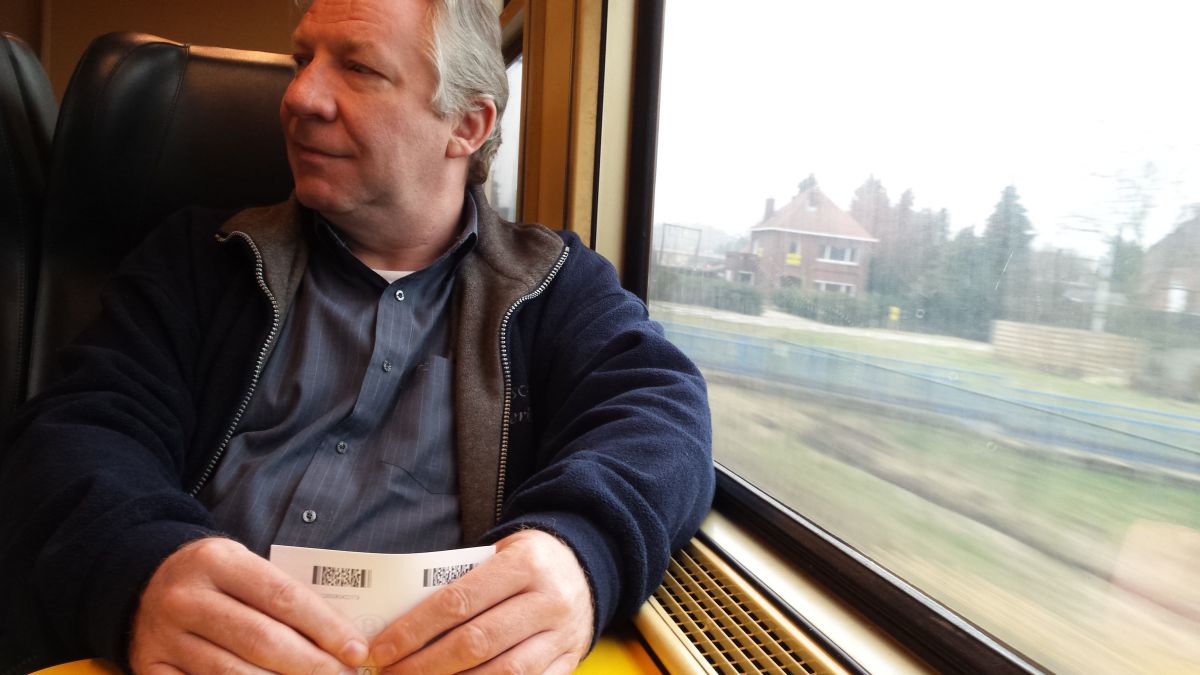 On the train to Antwerp
On the train to Antwerp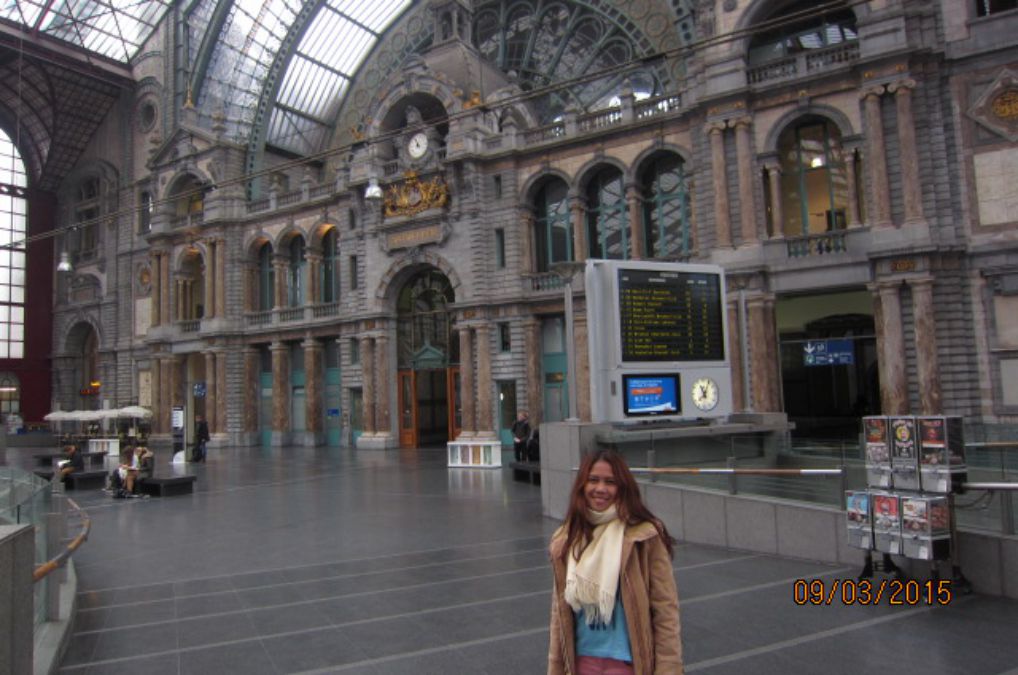 Antwerpen Centraal track side exit/entrance
Antwerpen Centraal track side exit/entrance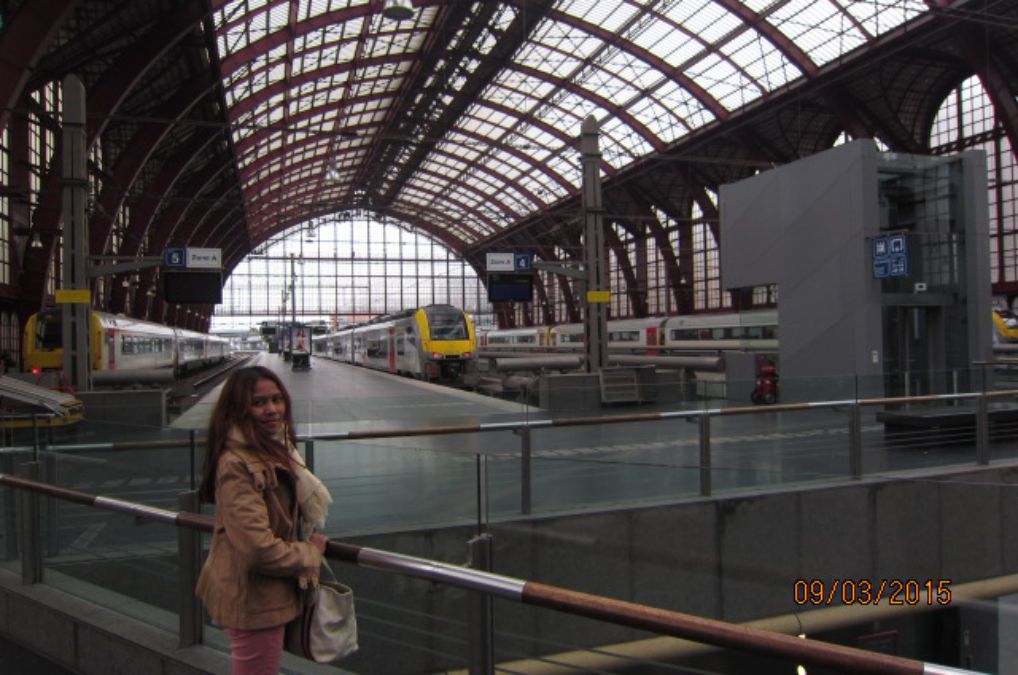 Antwerpen Centraal upper tracks
Antwerpen Centraal upper tracks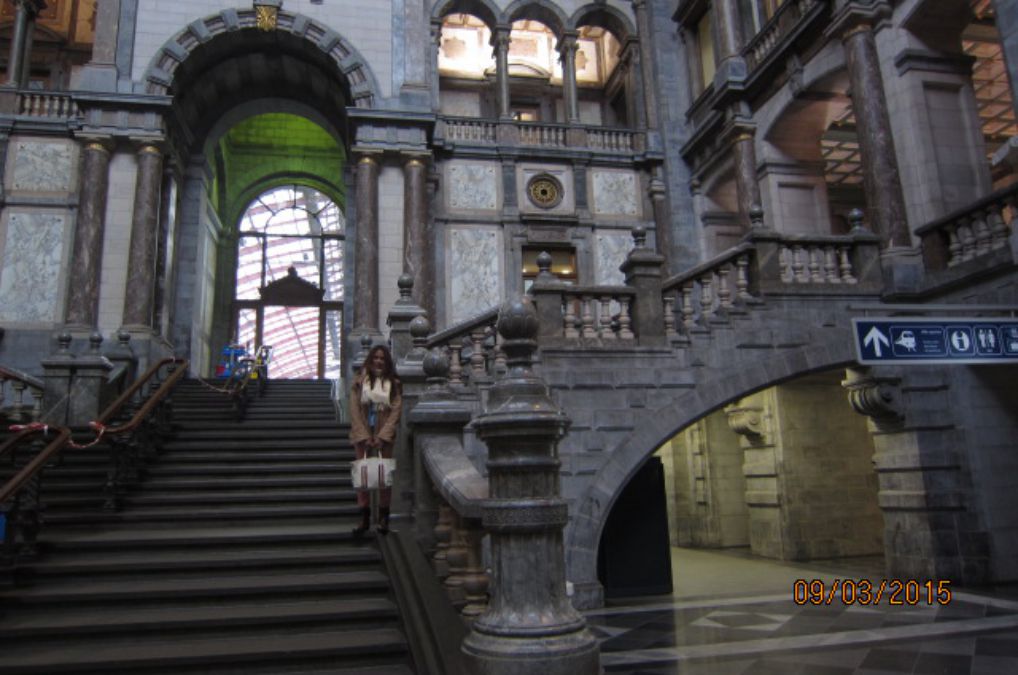 Antwerpen Centraal lobby staircase to tracks
Antwerpen Centraal lobby staircase to tracks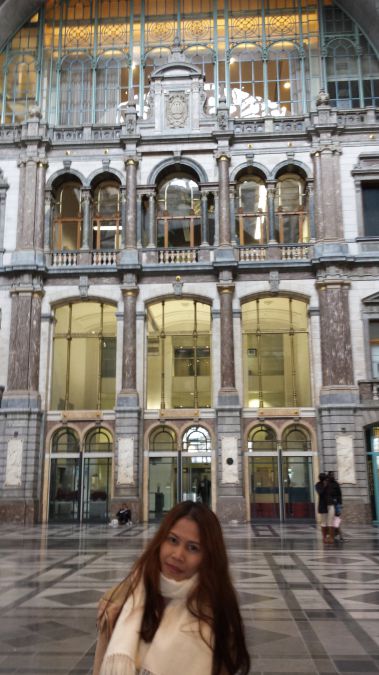
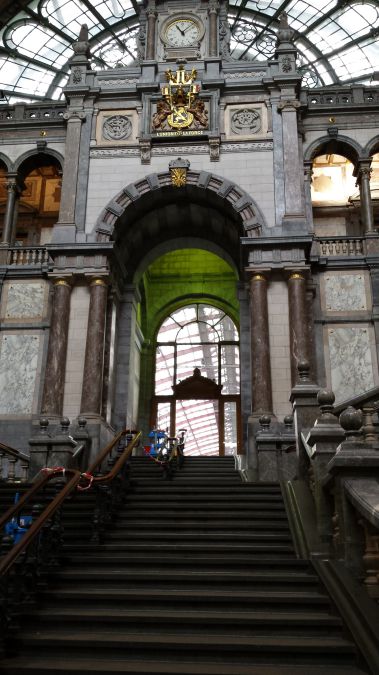 Antwerpen Centraal lobby architecture
Antwerpen Centraal lobby architecture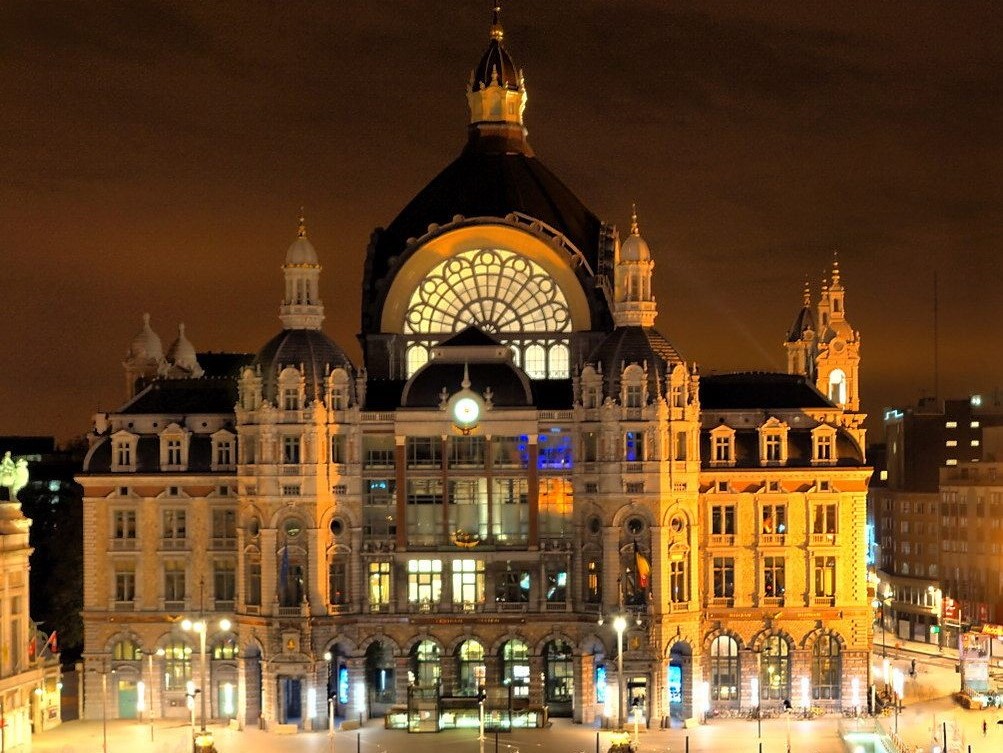 Night view of the Station's front
Night view of the Station's frontShort History of central Station
The original station building was constructed between 1895 and 1905 as a replacement for the original terminus of the Brussels-Mechelen-Antwerp Railway. The stone clad terminus buildings, with a vast dome above the waiting room hall were designed by Louis Delacenserie and the vast (185 metres long and 44 metres high) iron and glass trainshed by Clement van Bogaert. The viaduct into the station is also a notable structure designed by local architect Jan Van Asperen. The station is now widely regarded as the finest example of railway architecture in Belgium, although the extraordinary eclecticism of the influences on Delacenserie's design had led to a difficulty in assigning it to a particular architectural style.
In February 2009, the American newspaper 'Newsweek' found that the station deserved a 4th place as world's most beautiful station."
In 1835 the first train from Brussels to Antwerp arrived in Antwerp in a wooden station outside the city walls, in Koningin Astridplein. This structure was replaced in 1854 by a new wooden station building near the Antwerp Zoo’s current entrance: East Station. But King Leopold II felt that Antwerp deserved a more prestigious station. In 1895 Bruges-born architect Louis dela Censerie set to work. Ten years later Antwerp’s Central Station was officially inaugurated. The station consists of an elevated railway bed, a covered steel platform hall and a monumental station building for services and ticket hall.
Antwerp’s Central Station is considered one of the most beautiful stations worldwide. Between 2000 and 2009 the monumental building was completely modernised and expanded to accommodate the high-speed rail line. More platforms were opened on two additional underground levels, an additional entrance with station hall was built in Kievitplein and space was created for shops and restaurants. The unique metal platform roof had previously been restored. In the past Antwerp Central Station was a terminus where trains had to turn around. But since 2007, trains can continue their journey thanks to the railway tunnel between Antwerp Central Station and the north of the city.
Exiting Central station towards the Keyserlei, The first leg of a long shopping street. At one side are the Diamonds and Haute Couture shops, on the other sides mostly bars & restaurants with large terrasses in front. Even in winter some of the terrasses are partially covered
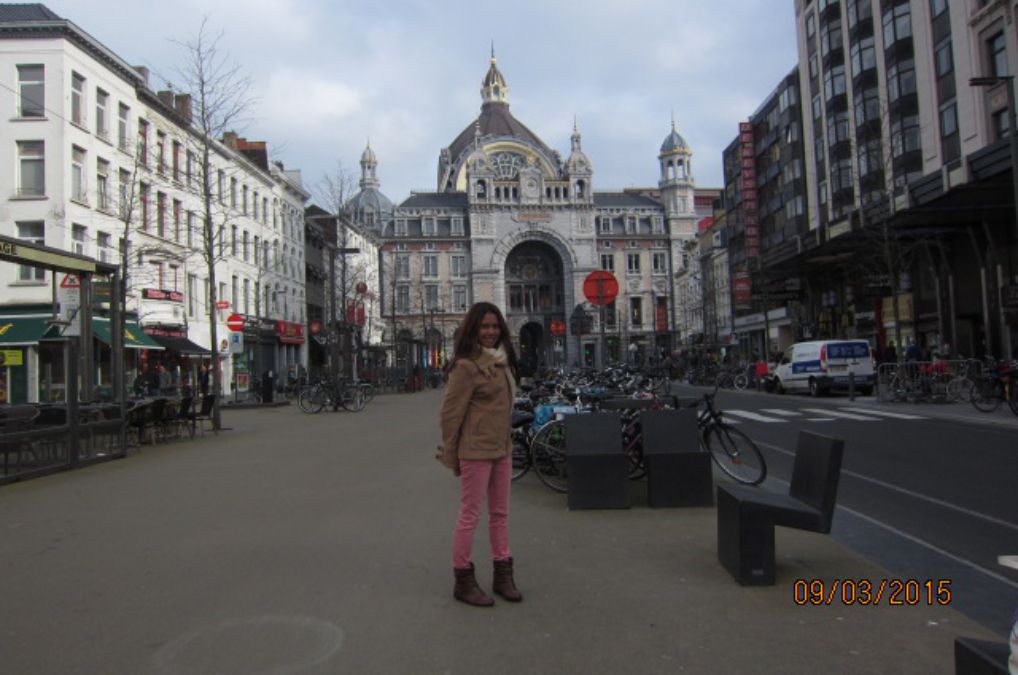 The Keyserlei in winter
The Keyserlei in winter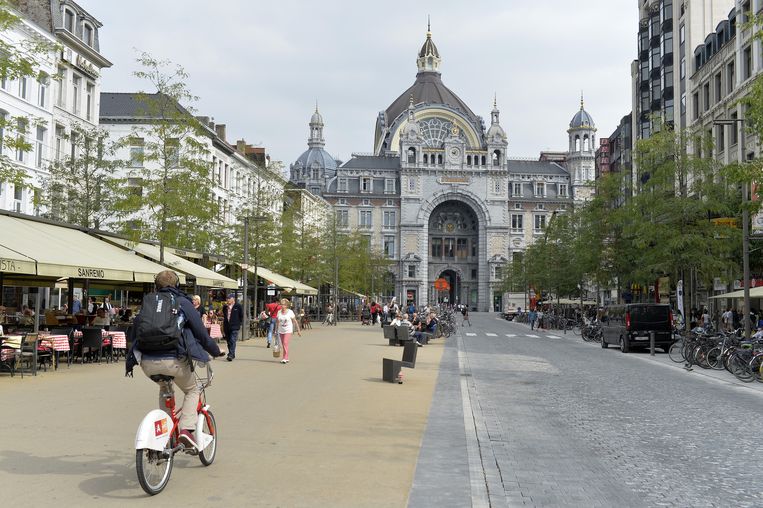 Keiserlei in the summer
Keiserlei in the summer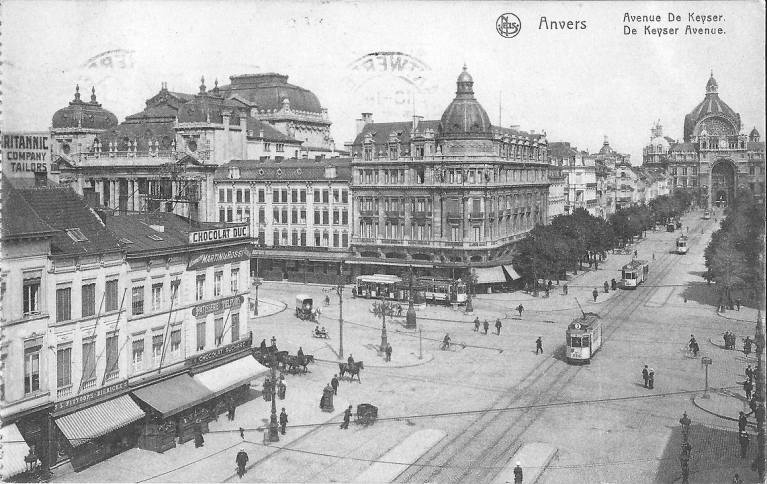 In the old days. Trams are in the center of the street
In the old days. Trams are in the center of the street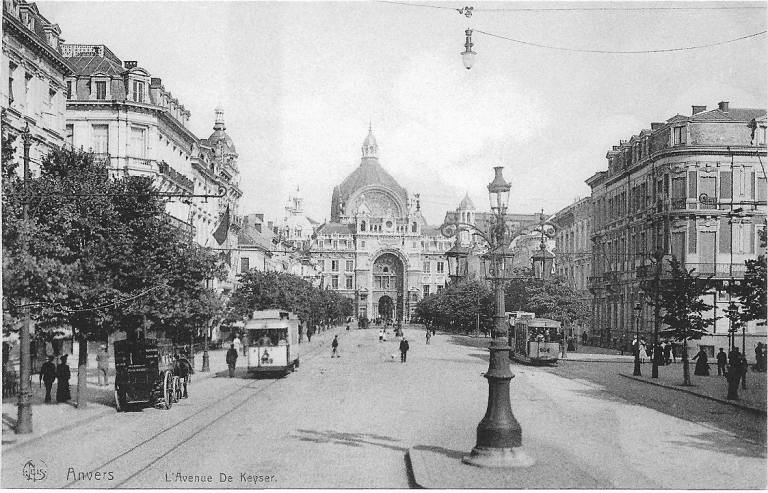 In the older days. Trams are on the side of the street
In the older days. Trams are on the side of the streetThe Keyserlei ends at the Frankrijklei. The next leg of shopping street continous crossing the Frankrijklei in to the famous Meir. The Meir is the most important shopping area, both by number of shoppers and by rent prices. The street has been mostly pedestrianised since 1993.
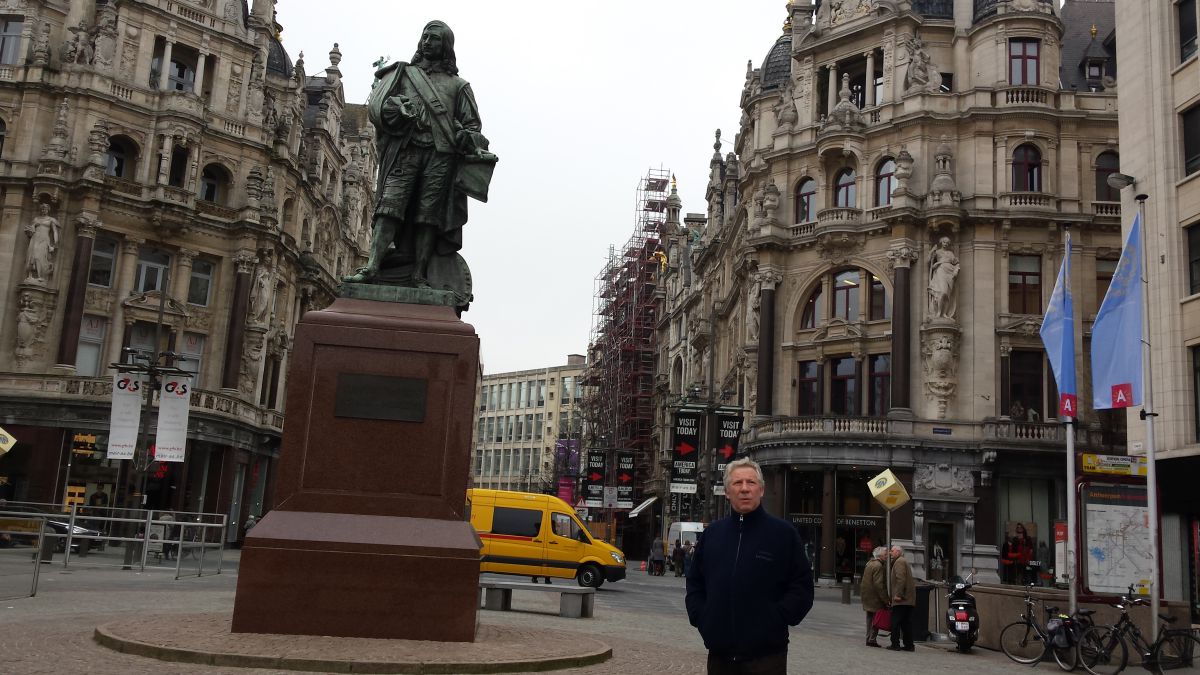 Painter David Teniers statue on the square named after him
Painter David Teniers statue on the square named after him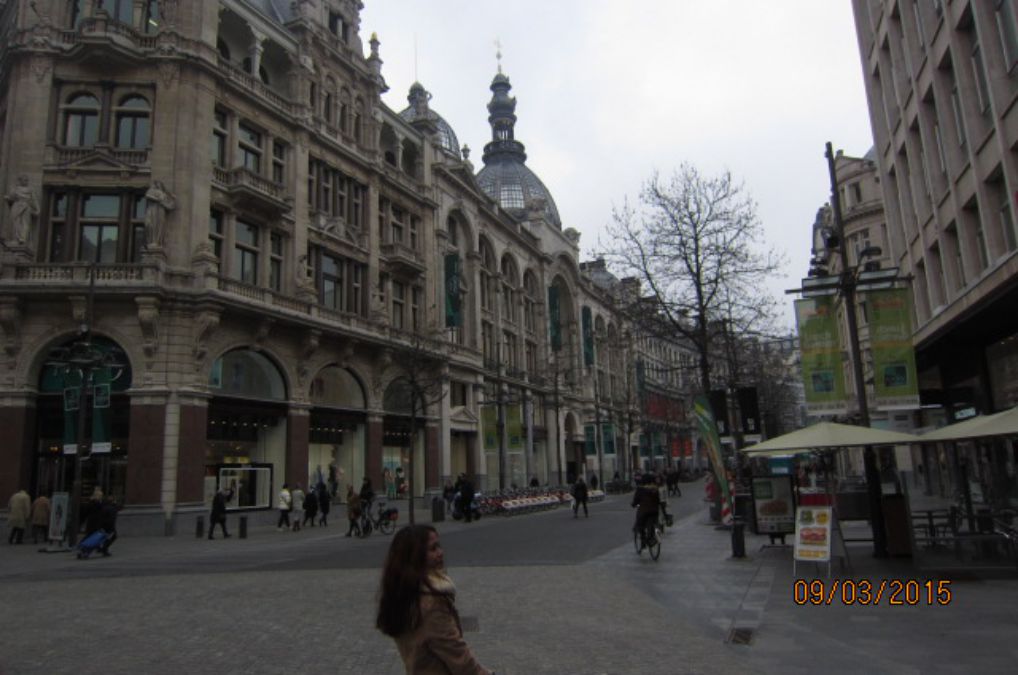 Keep walking on the Meir
Keep walking on the Meir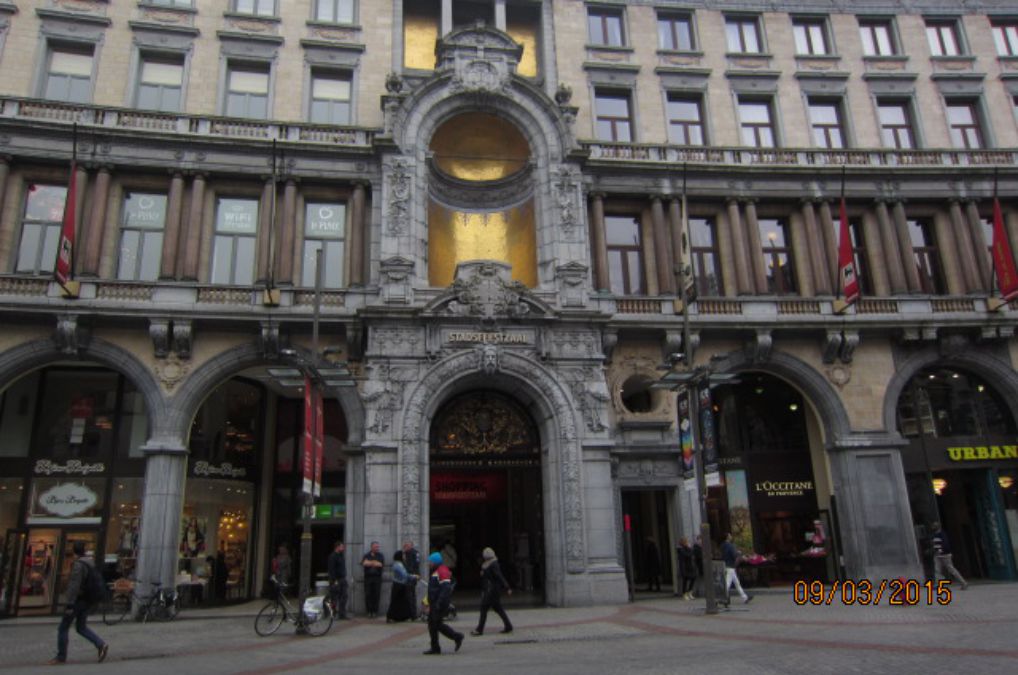 Historic City Festive mall
Historic City Festive mall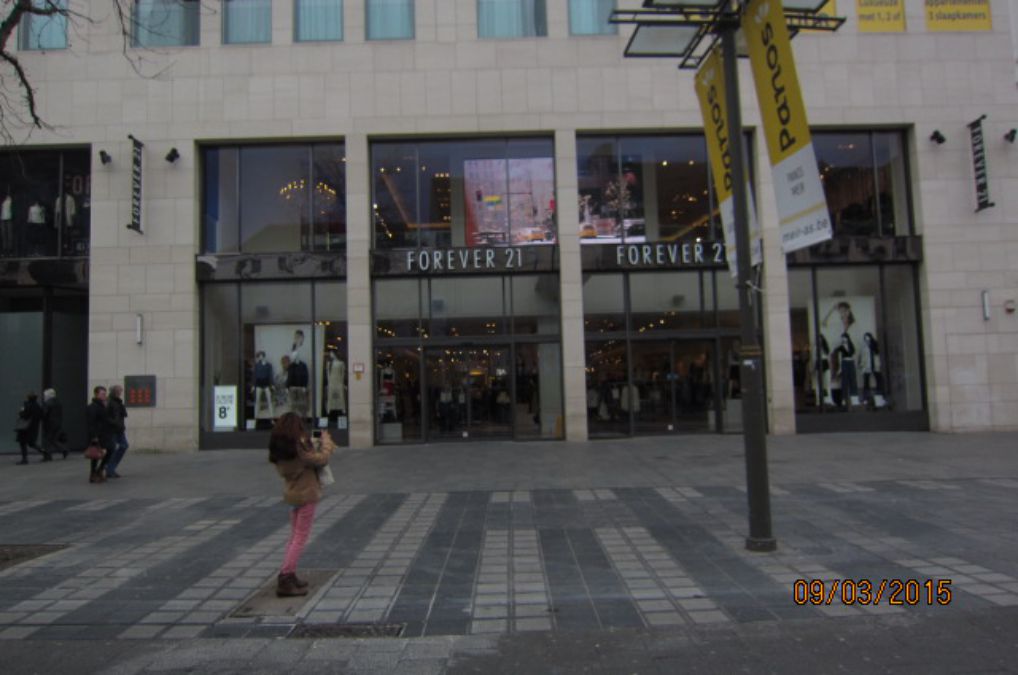 Modern Shopping mall
Modern Shopping mall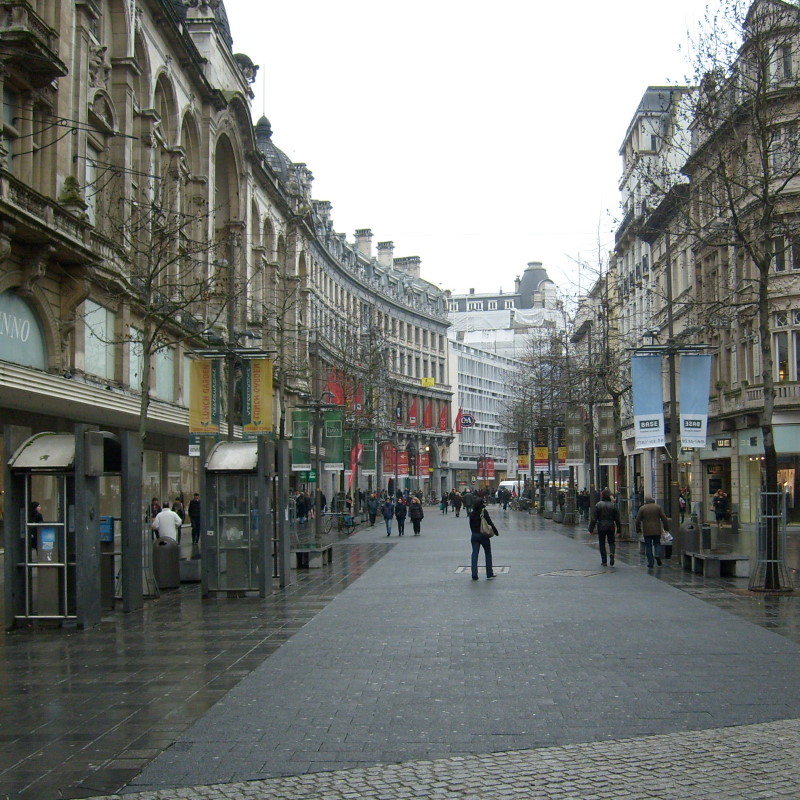 Meir is a pedestrian street
Meir is a pedestrian street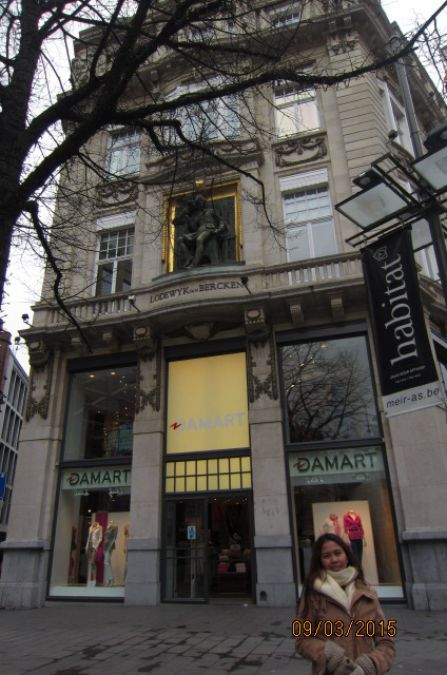 Building with statue of diamond cutter Lodewyk van Bercken
Building with statue of diamond cutter Lodewyk van BerckenEarly History
The oldest reference to the Meir dates back to 1257, when the street was not more than a low-lying area with a swampy lake, just outside the city borders. With the rapid expansion of the city during the following centuries, the Meir becomes urbanized and in the early fifteenth century it is a wide paved street with a canal at its center. Much of the street is already lined with houses.Sixteenth Century
At the turn of the sixteenth century Antwerp's growth intensifies even more as it expands to one of Europe's largest cities. Since the center of the city is now overcrowded, the Meir and surrounding streets become the place where rich patricians settle and build sumptuous mansions.
At the same time, a new large stock exchange is built close to the Meir, moving the city's commercial epicenter from the riverside to the Meir. During the first half of the sixteenth century the canal running through its center is covered, increasing the appeal of what is now Antwerp's most prestigious street.
The wide street is not only an important commercial street, it is also the site of many of the city's parades and events. While the city of Antwerp loses its powerful position on the international stage during the next centuries, the Meir still appeals to the rich who continue to build ever larger mansions. Some of the buildings of this period have survived, such as the Royal Palace, built in 1748.
From thoroughfare to pedestrian street
With the contruction of the Central Station at the turn of the twentieth century, the Meir's function as a main thoroughfare is now more evident than ever as it is leads from the historic city center right towards the new railway hub. To accommodate the growing traffic, the Meir is widened even more and grand buildings are erected such as the City Event hall or "Stadsfeestzaal" and the Innovation, a large modern department store.
At the end of the twentieth century the Meir is still the city's most important shopping street, but clogged with traffic. In the 1980s the tramway moved underground and in 1993, when Antwerp was designated the European Capital of Culture, the street was pedestrianized. But even without car traffic, the Meir maintained and even solidified its position as the region's prime shopping street.
From the Meir, we cross over to the Meirbrug street, passing along the formerly called Farmers Tower or "Boerentoren", today called the KBC (bank) Tower, and end up on the Green Place or "Groenplaats".
Once a cemetery in the heart of the city, the Groenplaats is now one of Antwerp's most popular squares. It is a perfect place for drinking one of the many local beers.
Since 1843 a bronze statue of artist Rubens graces the center of the Groenplaats. It replaced a large crucifix that stood here. The statue honors Antwerp's most famous citizen, the prolific painter Pieter Paul Rubens, whose dramatic Baroque paintings are displayed in churches and museums all over the world. He lived here from 1587 until his death in 1640.
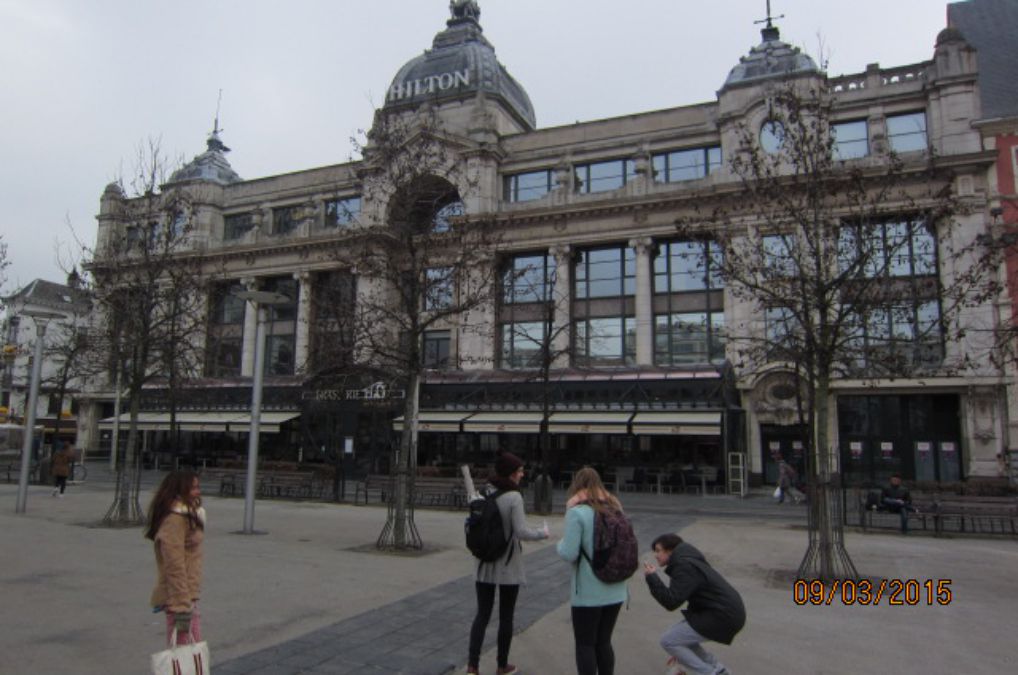 Hiton Hotel (the former Grand Bazaar)
Hiton Hotel (the former Grand Bazaar) Statue of painter Rubens. The "Cathedral of Our Lady" in the background
Statue of painter Rubens. The "Cathedral of Our Lady" in the background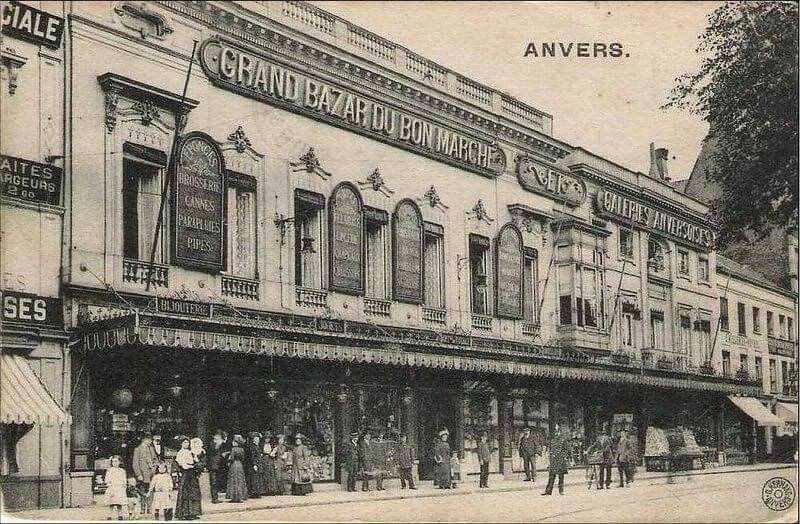 The old 'Grand Bazaar'
The old 'Grand Bazaar'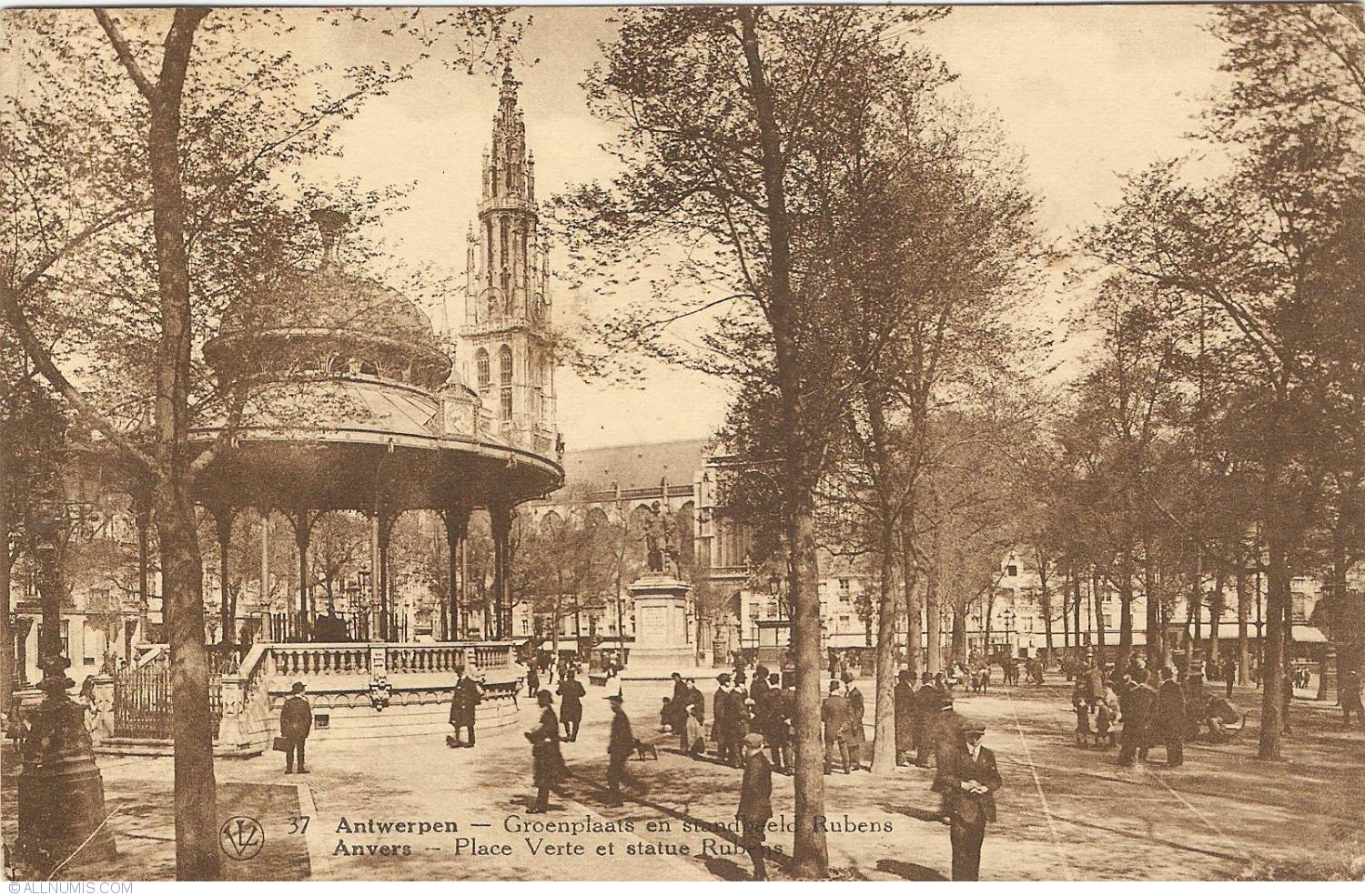 Green Place in earlier times
Green Place in earlier timesContinuing our walk to the Cathedral of our Lady or "De Onze Lieve Vrouwe Kathedraal" (Cathedral of our Lady) is a masterpiece of lace work in stone.
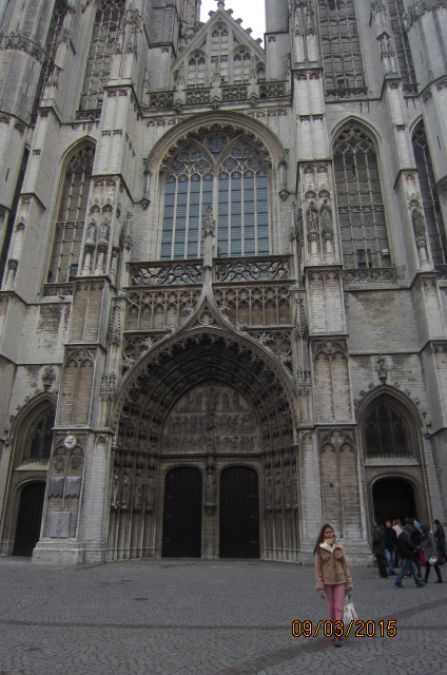 Cathedral of our Lady seen from the Hand-glove market or "Handschoenmarkt"
Cathedral of our Lady seen from the Hand-glove market or "Handschoenmarkt"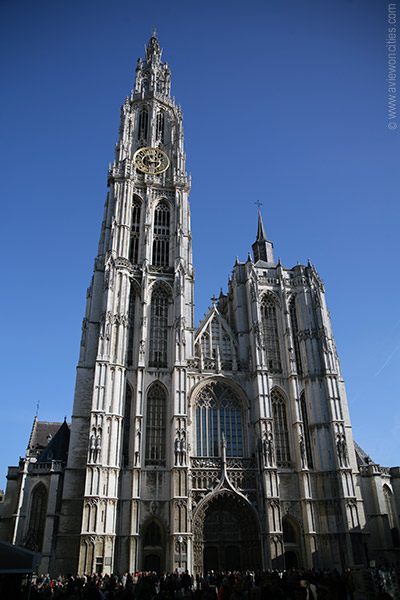 Cathedral of our Lady north tower reaches 123 meter (405ft)
Cathedral of our Lady north tower reaches 123 meter (405ft)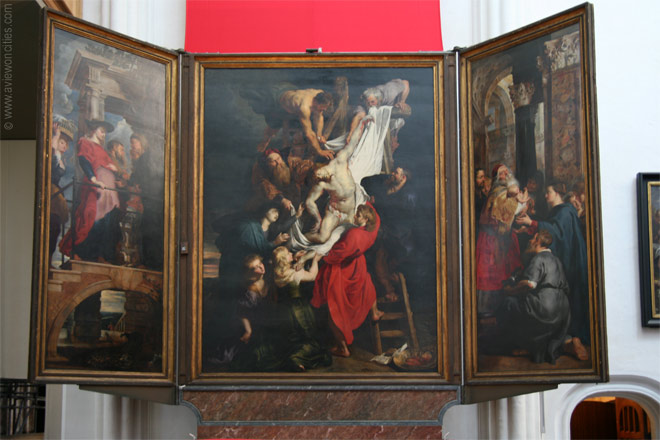 Inside the Cathedral. Painting by Rubens: Descent from the Cross
Inside the Cathedral. Painting by Rubens: Descent from the Cross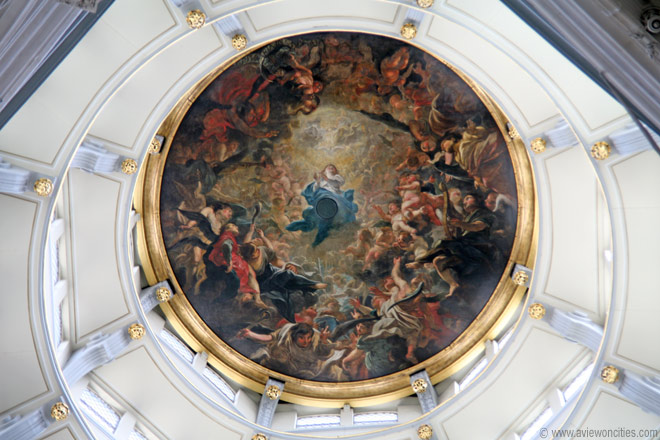 Cathedral ceiling painting
Cathedral ceiling painting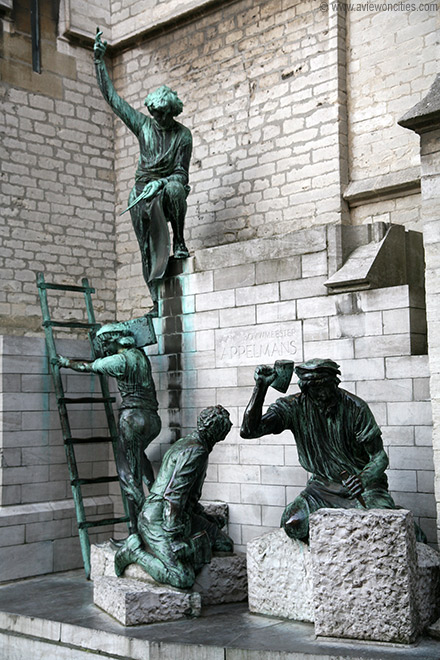 Monument to master builder Appelmans
Monument to master builder Appelmans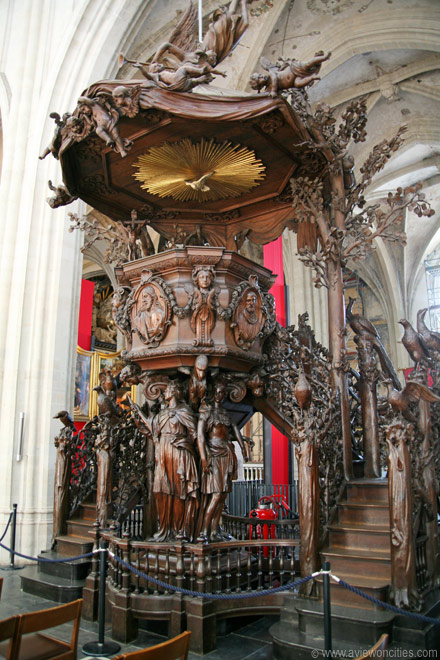 Cathedral Pulpit
Cathedral Pulpit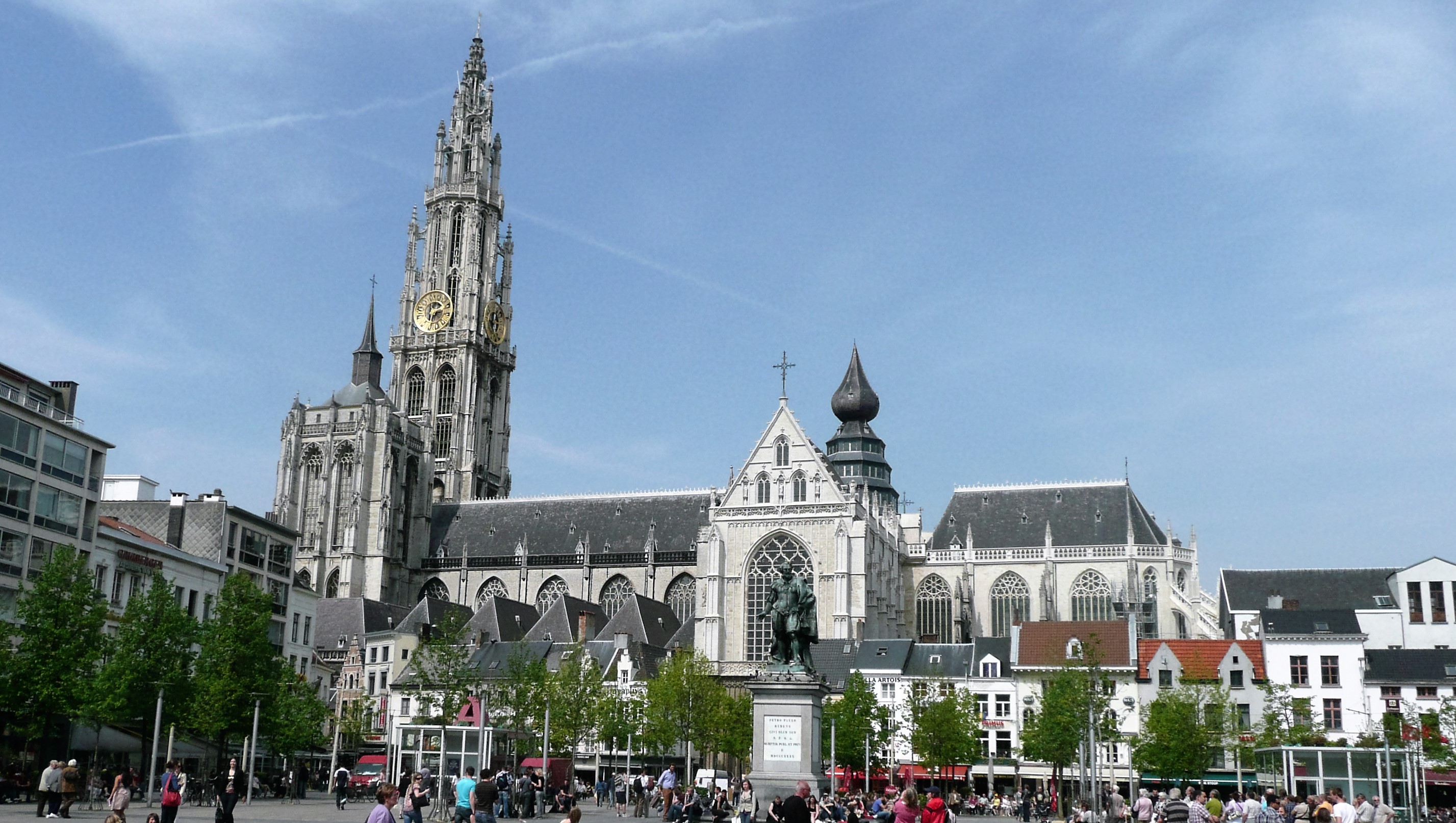 Cathedral of our Lady seen from the Green Place
Cathedral of our Lady seen from the Green PlaceHistory
Begun in 1352, it is one of the finest gothic buildings in Europe. The church, which became a cathedral in 1559 replaced a Romanesque church built in the twelfth century. The last vestiges of that church were demolished in 1481.
The overall design of the Antwerp Cathedral is attributed to Jean Appelmans, also known as Jean Amel de Boulogne, although the construction was most likely headed by De Waghemakere. A nineteenth-century monument at the base of the southern spire commemorates the architect.
The choir and nave were built first between 1352 and 1411. The west front was built later, between 1422 and 1474.The Tower
The last part, the tower, was finished in 1518. Of the two planned towers, only the northern was finished. The octagonal portion of the tower, constructed between 1501 and 1507 was designed by Herman de Waghemakere. Inside the tower is a carillon with forty-seven bells. The actual spire was built by Domien de Waghemakere, Antoon Keldermans II, and Rombout Keldermans between 1508 and 1518.
The cathedral was the tallest structure in the Low Countries for several centuries. Even now, the 123 meter (405ft) tall spire reigns over the city. Partly due to height restrictions in Antwerp, it is still the tallest building in the city. As an example of the aspirations of Antwerp in its golden age, Emperor Charles V laid the first stone of a significant extension, three times the size of the current one, which would make it the largest building on earth. Water damage resulting from a severe fire in the nave in 1533, which destroyed the ceiling and the Gothic furniture, prevented the construction of this megalomaniac project.Interior
The wide central nave is flanked by three aisles on each side, creating a huge interior space with forty-eight pillars in each aisle. The cathedral has a length of 117 meters and a width of 65 meters at its widest point (384 x 213 ft).
In 1566 and again in 1581, the interior of the cathedral was badly damaged by the Calvinists during the iconoclastic furies. In the eighteenth century, the French even threatened to demolish the building entirely. Fortunately, the city architect could hold off those plans. During the French occupation, most of the interior was sold by the French.
Despite all the plundering, some major art treasures have survived. The most notable are three large paintings by Rubens: Descent from the Cross (1612), Elevation of the Cross (1610) and the Resurrection Triptych (1612). There are many more notable objects inside like altars, confessionals, statues and the pulpit. The main relic that survived the middle ages is the bronze tomb of Isabella of Bourbon. The cathedral also features thirty-four huge stained glass windows.
A few more steps and we are on the Grand Market or "Grote Markt". The centerpiece of the square is a large fountain. It depicts the mythical hero Brabo, throwing a large hand. Of course the monumental City hall cannot be ignored. At the time, there was an exibition in City Hall. But first we had lunch!
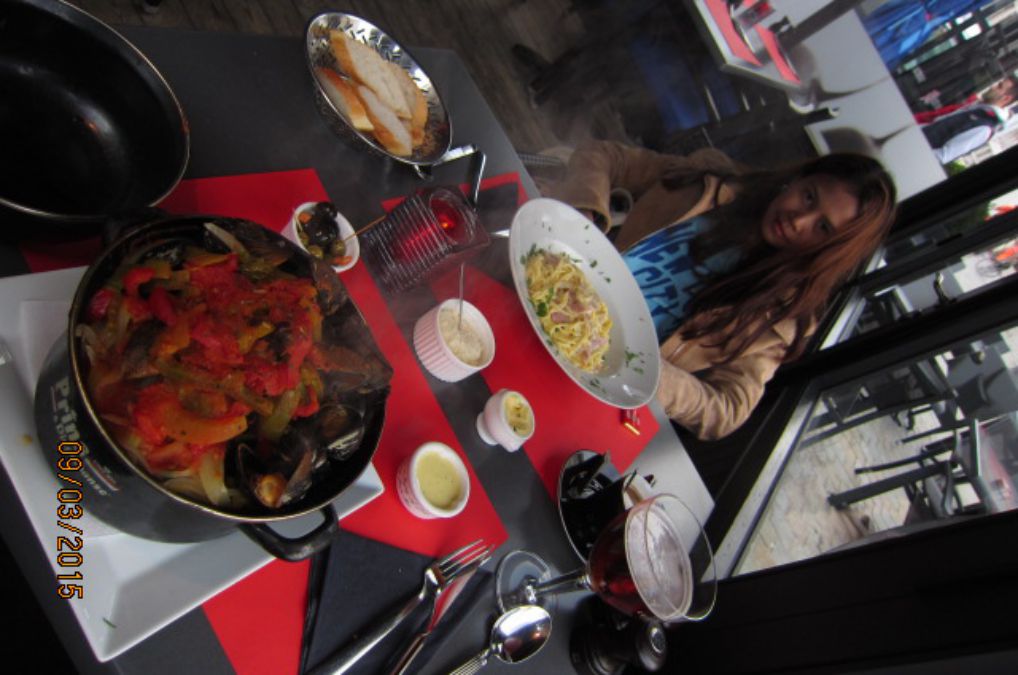 Mosselen friet and pasta carbonara
Mosselen friet and pasta carbonara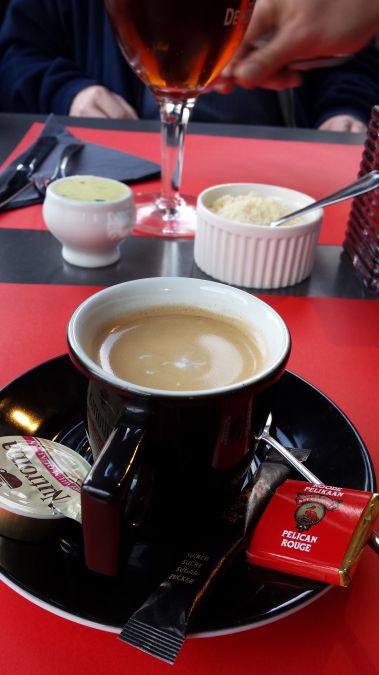 Finish with a coffee and a beer "De Koninck"
Finish with a coffee and a beer "De Koninck"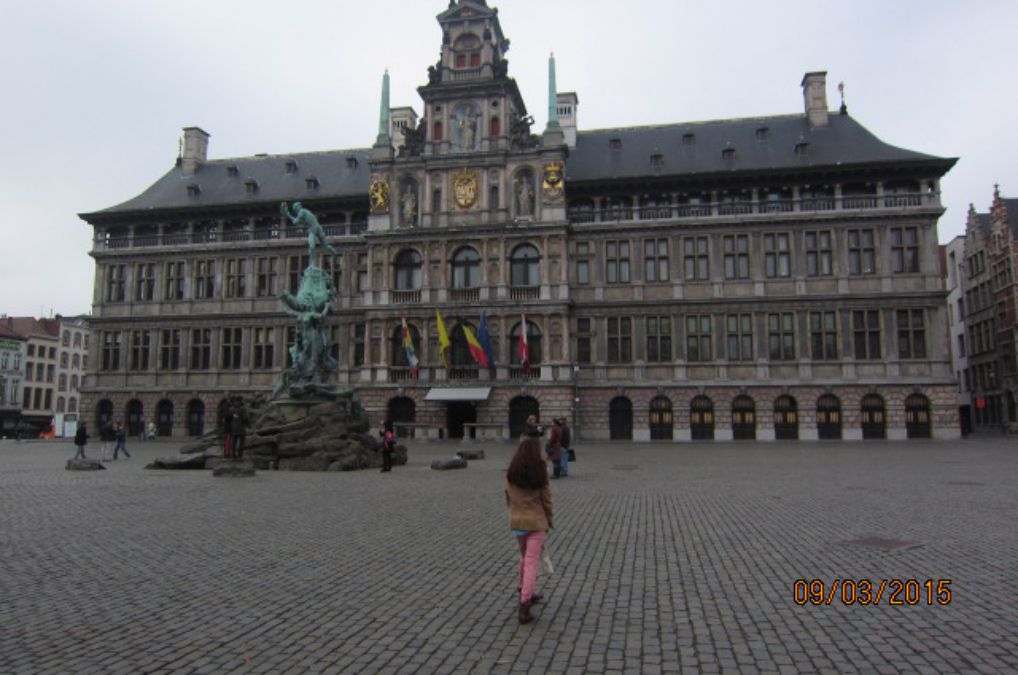 City Hall. The fountain with Brabo in front
City Hall. The fountain with Brabo in front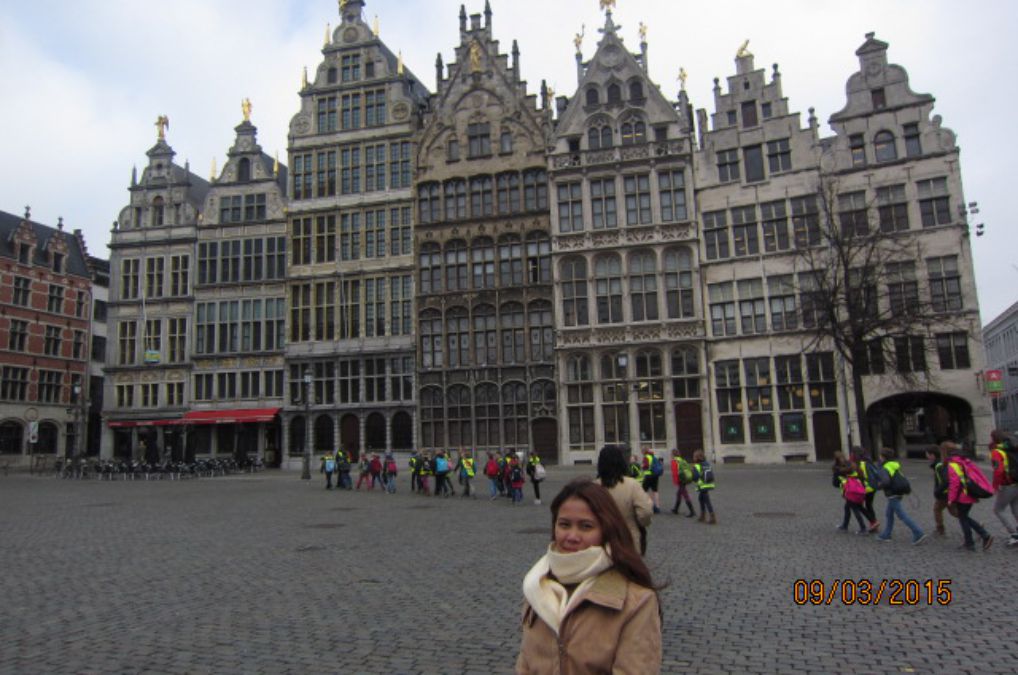 The Guild houses.
The Guild houses.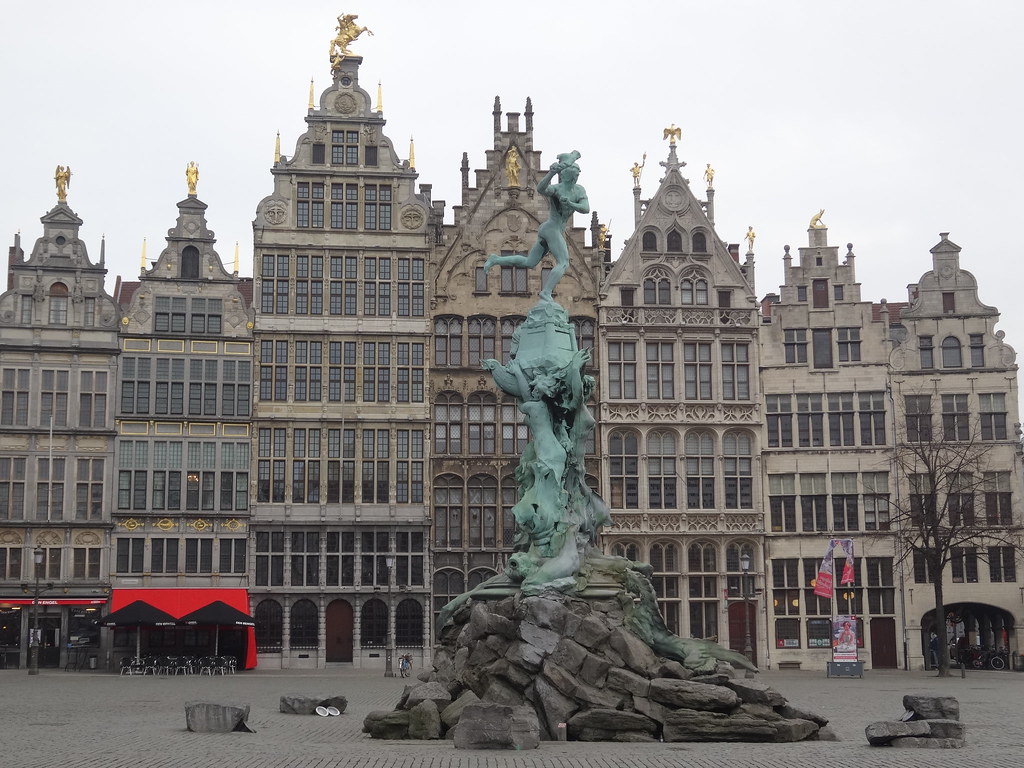 Guild houses and Brabo from another angle
Guild houses and Brabo from another angle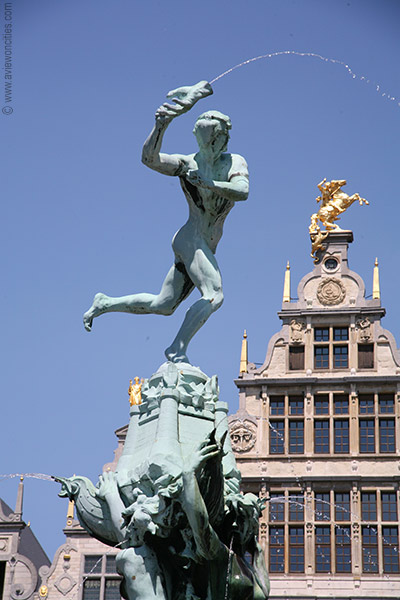 Brabo throwing the hand
Brabo throwing the hand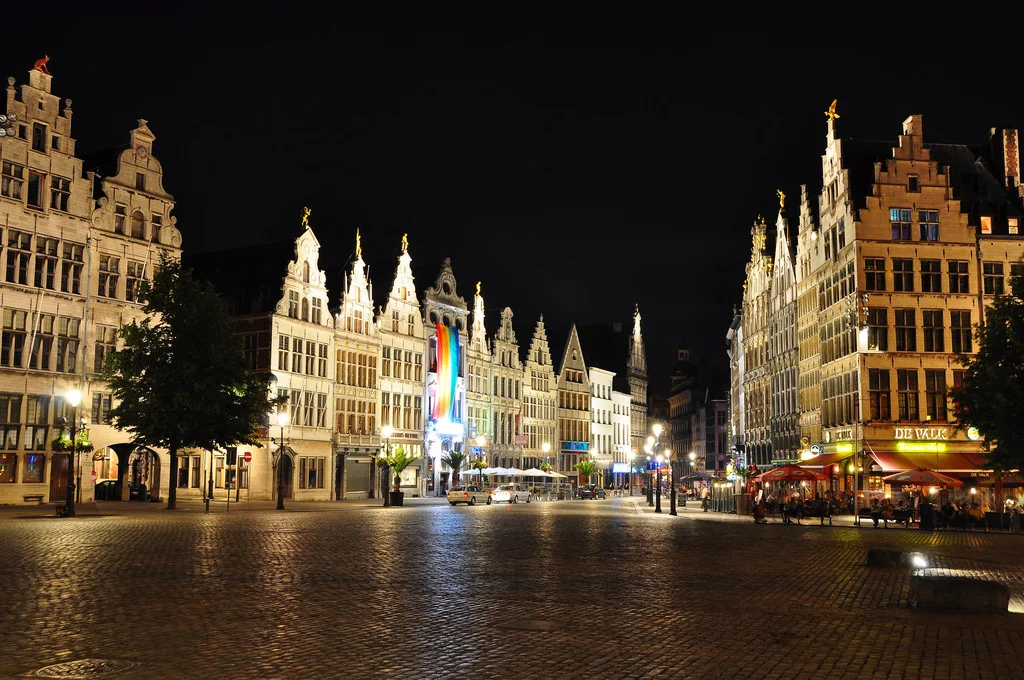 Market Palce by night
Market Palce by night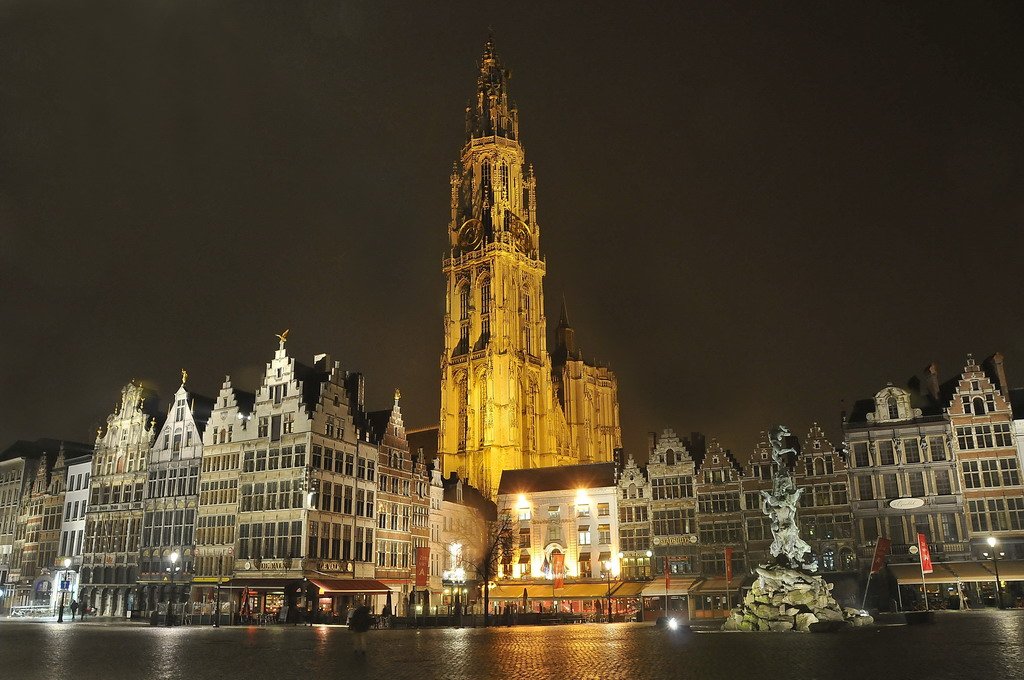 The Cathedral of Our Lady overlooking the Grand Market
The Cathedral of Our Lady overlooking the Grand MarketWalking to the river Scheldt or "De Schelde", The Stone or "'t Steen" is our last attraction. The oldest building in Antwerp is an 800-year old castle. What remains today is only a fraction of the once mighty castle that formed the nucleus of the city.
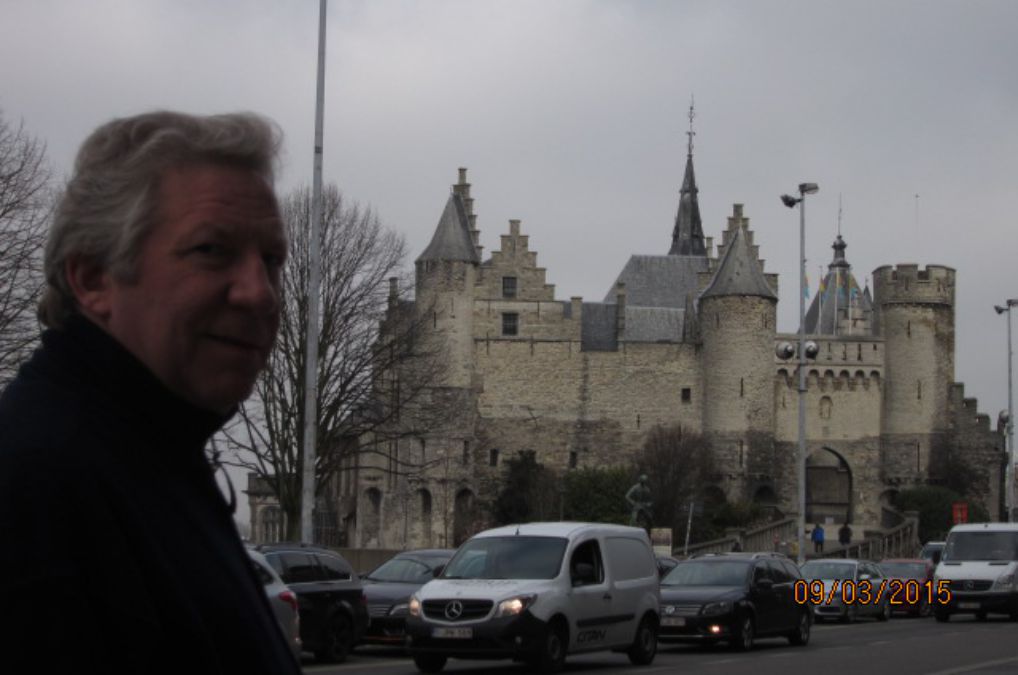 The Steen
The Steen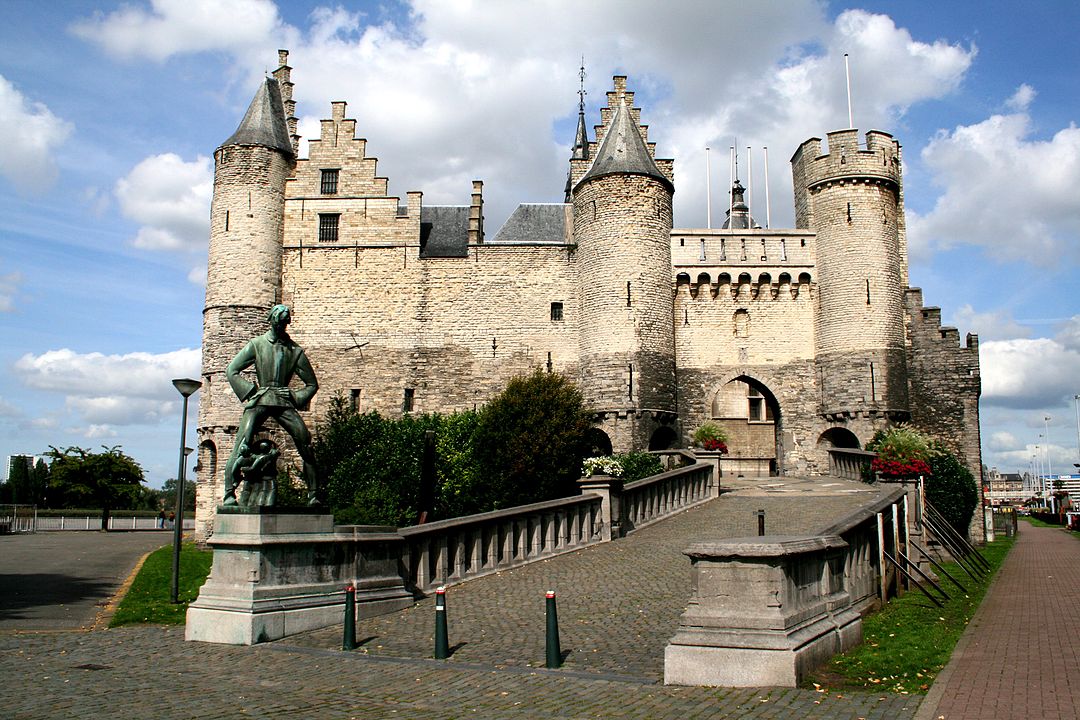 Inclined ramp leading to inner courtyard
Inclined ramp leading to inner courtyard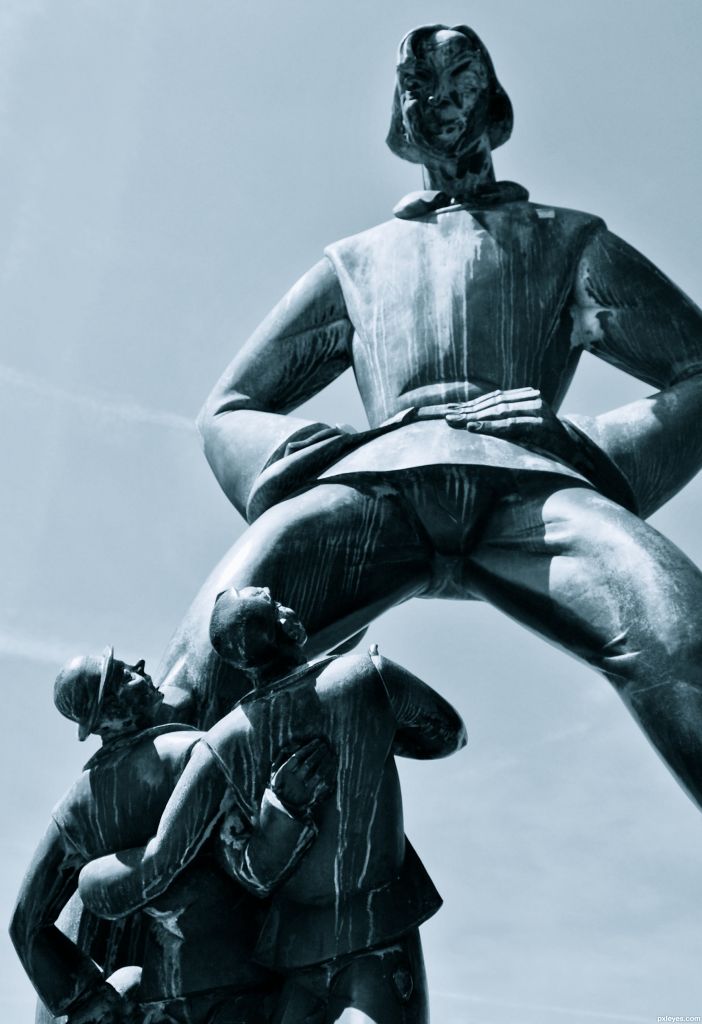 Legendary Lange Wapper
Legendary Lange Wapper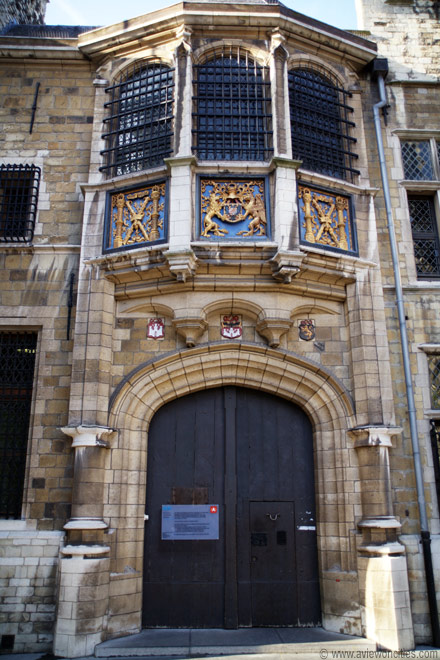 Living quarters at
the courtyard
Living quarters at
the courtyard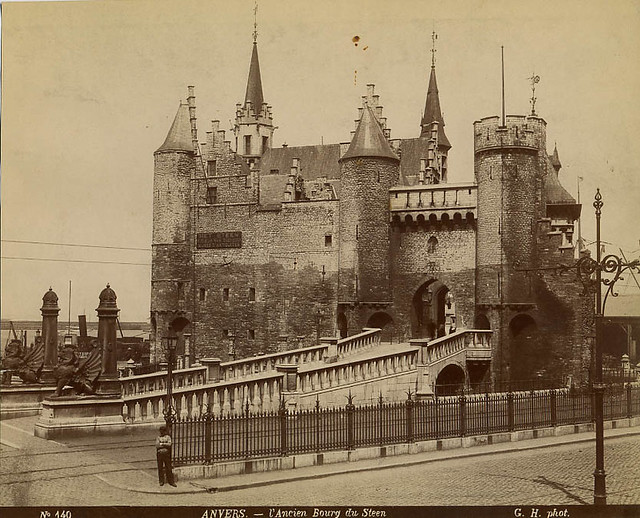 Steen in the early 20th century
Steen in the early 20th century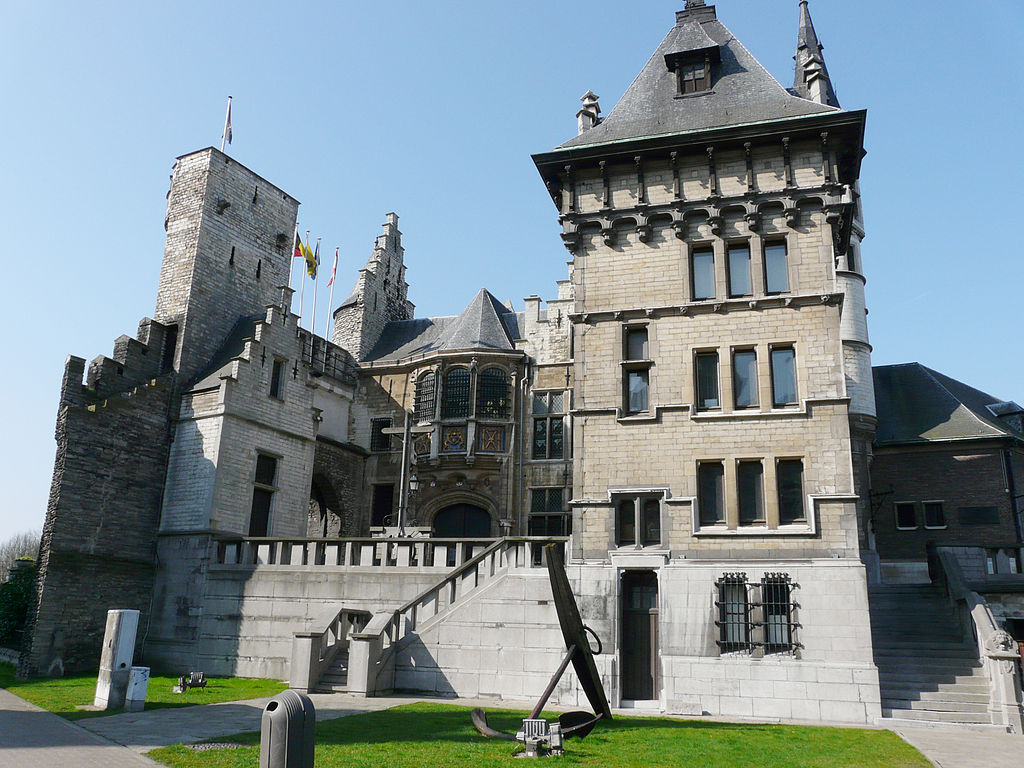 East Facade
East Facade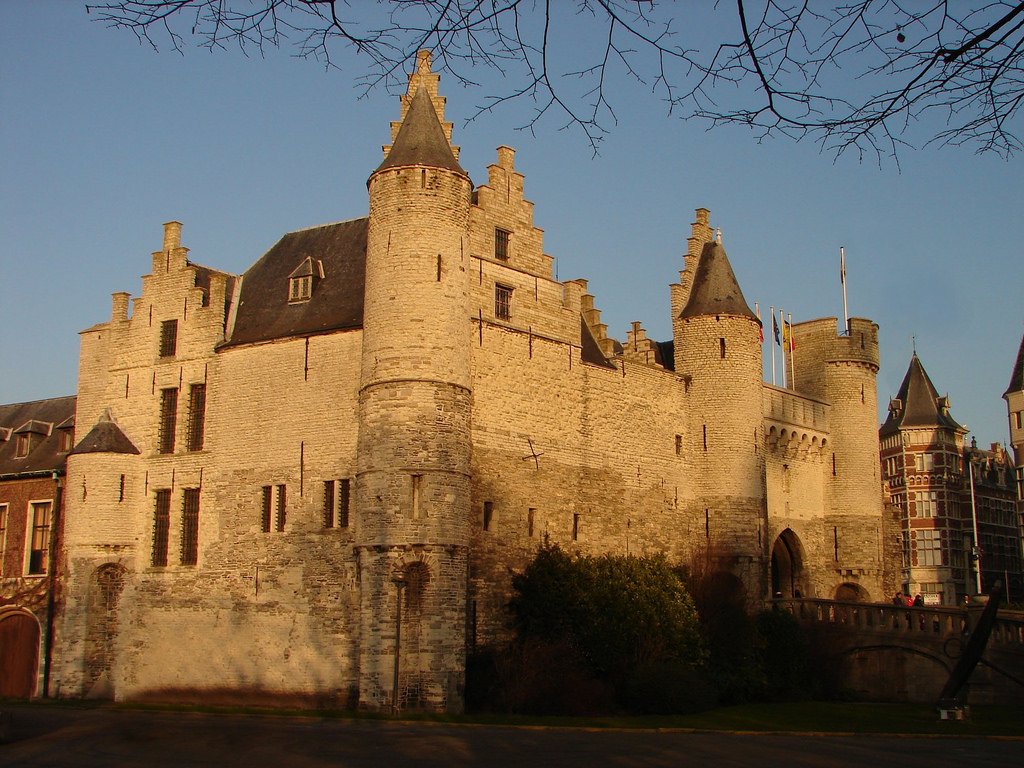
Now standing rather desolate at the quays, the building was once the center of the city's oldest neighborhood - known as the Oude Werf - with narrow streets, gates, towers and a fish market.The thirteenth-century Castle
The Steen was built around the year 1200 at the site of an older, 9th century fortress. It was named Steen as it was the first large building constructed in stone. What we see now is only a small part of this castle, which at one point was almost six time the current size. It served as the home of the burggrave of Antwerp and included a church (St. Walburgis), a courthouse, a warehouse, a monumental gate and several other buildings. The complex was Steen surrounded by a large defensive wall.Sixteenth-century Renovation
The Steen was altered several times during history, most notably in 1520 when Emperor Charles V ordered a thorough renovation of the castle, carried out by the architects Rombout Keldermans and De Waghemakere, both of whom also worked on the construction of the cathedral. The chapel above the entrance dates from this period. It is very easy to see which part of the castle is still original: the thirteenth-century masonry is much darker than that of the sixteenth century, hence the two-colored tone of the front facade. From 1549 until 1823 the building served as a prison and in 1862 it became an archaeological museum.Escape from Demolition
In the nineteenth century, the city decided to widen the river and construct new quay walls to accommodate the growing harbor traffic and to prevent the river from becoming silted up. The only problem? The whole historic center around the castle had to be demolished. Since the harbor was considered of vital importance for the future of the city, the project went ahead nonetheless. During the construction of the new quays more than five hundred buildings were demolished. The Steen survived - barely, the city council voted in favor by just a single vote - and was renovated between 1889-1890. Still most of the castle was demolished, and only the gate and burggrave's house now stand stranded at the quay.The Steen Today
The most imposing remainder of the original castle is the entrance gate. Above the entrance gate is a small statue of Semini, a pagan god of youth and fertility. According to local legend he was the forefather of the people of Antwerp. In 1587 the Jesuits, a fanatical religious order, mutilated the nude statue.
An inclined ramp leads to a small inner courtyard, the only part that remains of a network of eight streets. The east side of the castle shows a colorful relief with the emblem of Charles V.
Until the end of 2008 the Steen was home to the National Maritime Museum. Its collection moved to the new MAS museum in 2010 but a new Maritime Museum is expected to open in 2023 in the old harbor. You can however still visit a number of old vessels that are located near the old castle. There are plans to convert the castle into a cruise terminal / visitor center by the year 2020.Lange Wapper
Near the entrance of the castle stands one of Antwerp's most famous statues: the Lange Wapper. The statue, created by Albert Poels in 1963, depicts the legendary figure of Lange Wapper who, according to Antwerp folklore, could grow to the size of an enormous giant. He was said to have a devilish character and enjoyed teasing people.
Walking back to Station Centraal, buying some souveniers en shopping here and there, we take the tranin Back to Aarschot.


Comments powered by CComment